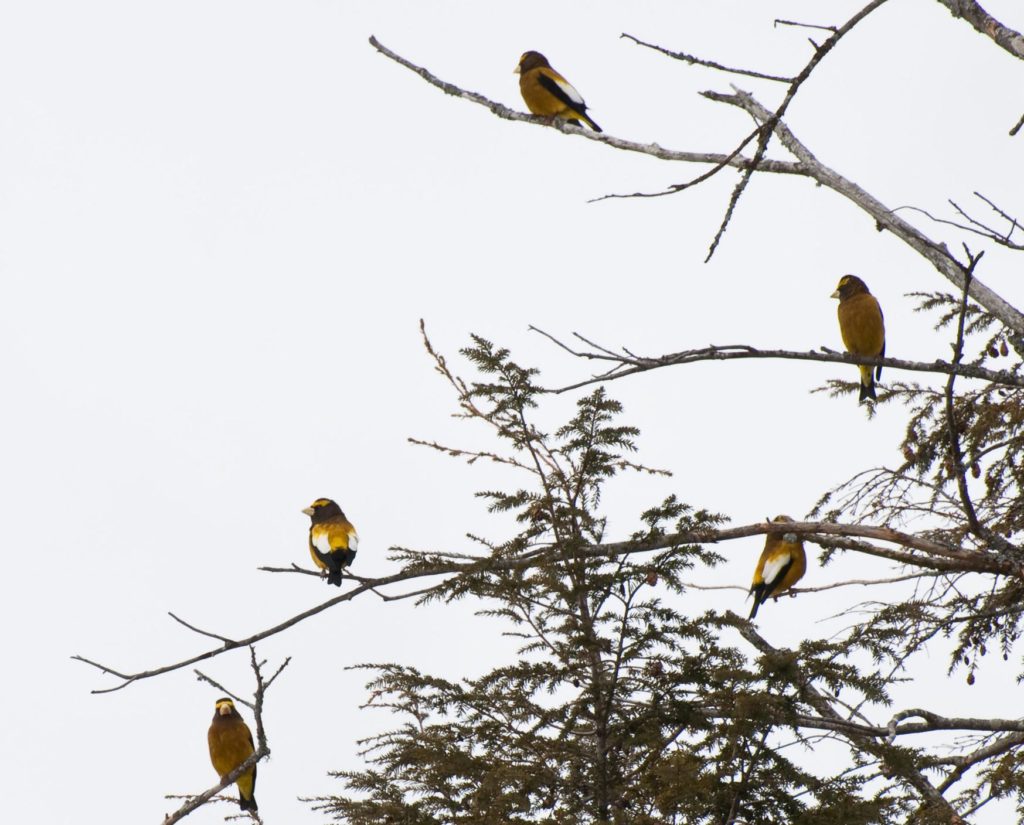
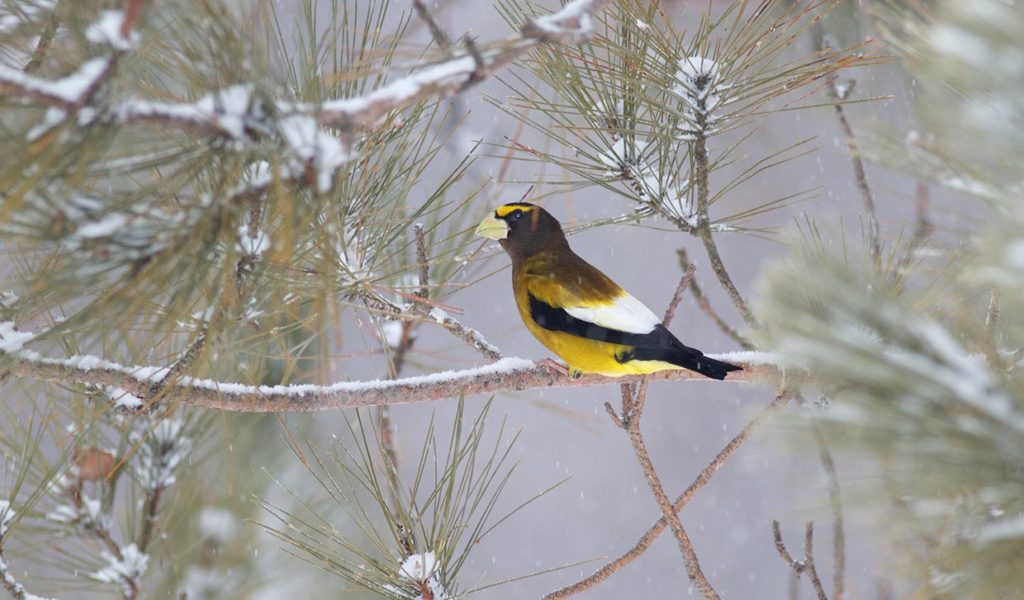
Just stopping by – checking in on the Evening Grosbeak
By Anne Queenan, Contributor
Deep in thought, Betty rinsed off the breakfast dishes, like she did every morning in her St. Louis County farmhouse in Minnesota, when a flash of yellow darted by the window. Looking up, she discovered her hedge of lilacs, the tops of her cedar trees and her entire lawn and gravel driveway to be completely engulfed in a canopy of yellow, black and white birds. Hundreds and hundreds of Evening Grosbeaks, all in motion, foraging and eating seeds, darting from branch to branch. She loved Evening Grosbeaks, particularly the bold yellow on the male that always brightened up a gray winter day at the feeders. And, oh, the volume of the trilly chatter they created that morning! Never before in her 60 years living in the northwoods had her backyard been blanketed with such a natural phenomenon.
For Betty Rauvola of Floodwood, MN the significance of such an occasion was deeply personal and packed with meaning. Only days before, she had sought out, actually prayed, for some sign that her husband, Lenard, who was battling Stage 4 cancer in 2010, would be ok once he transitioned from this earthly world. To her, this unexpected flock of birds was reassuring, but now there’s concern that these brightly colored birds are in decline.
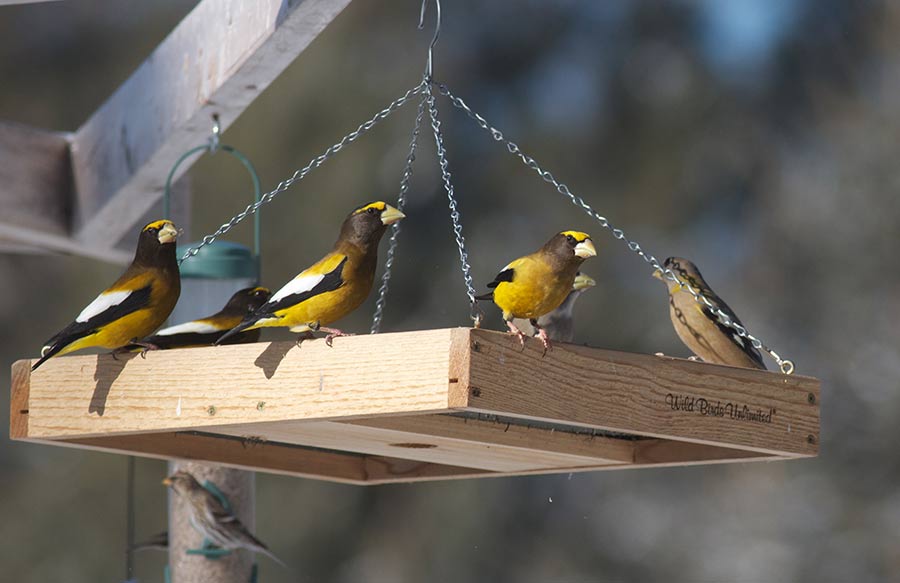
A Grosbeak Irruption
This type of surprise arrival of birds en masse is known as an irruption, and it is classic behavior from this robin-sized member of the finch family. An “irruptive bird” irregularly flies south of its normal winter range, usually in large flocks, seeking food. Often Evening Grosbeaks have come to the southern edge of the boreal forest in the late fall, sometimes extending from Northern Minnesota to the Rockies. Some birds even make it to pine forests in Mexico. To them, it’s all about the food.
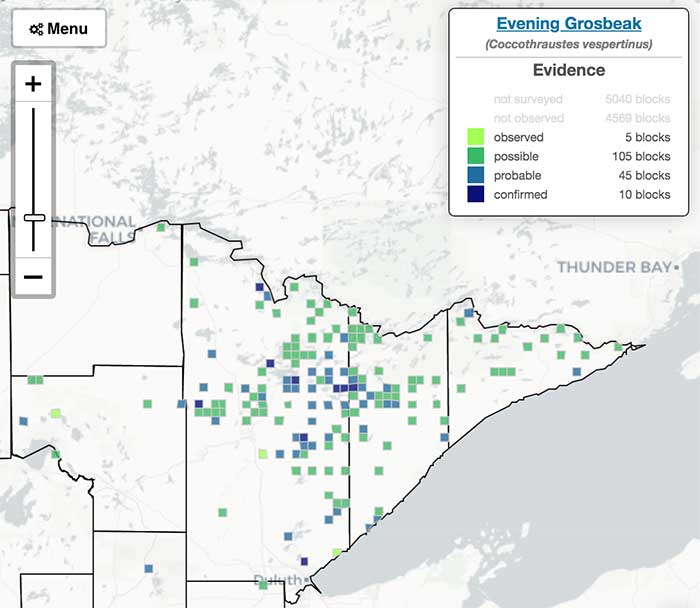
Irruptive species vary in number from year to year, depending on the scarcity of food in their nesting grounds. For many Evening Grosbeaks, nesting grounds are the northern boreal forest of Canada and Alaska. Some have been found to nest in the United States, including northeast Minnesota, as well as Upper Michigan and Maine.
The nomadic behavior of the Evening Grosbeak makes it difficult to see the big picture from annual counts in bird surveys with accuracy – coupled with the fact that they are tough to find, nesting high in the branches of evergreens, and lacking a recognizable song used to defend their territory. Irruptions are also why Evening Grosbeaks have been known in the past to be “commonly irregular,” meaning a common bird frequently seen on an irregular basis.
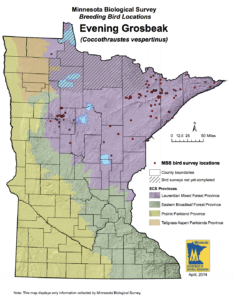
Dropping numbers in North America
Recently, however, surveys measuring the population of the Evening Grosbeak have indicated the species has now become uncommon, steeply declining in numbers in North America since 1970. Partners in Flight (PIF), is an extensive bird conservation network focusing on the western hemisphere. It describes the Evening Grosbeak as having “the dubious honor of experiencing the steepest population decline (92% since 1970) of all land birds in the continental U.S. and Canada.” It’s been assigned a Continental Concern Score of 13/20 by PIF. The Minnesota Department of Natural Resources and Minnesota Biological Survey records breeding locations.
A closer look at where decline is more prevalent
The initial decline in population has been most prevalent in the northeastern part of the United States and Canada, where spruce-fir forests have become vulnerable and are transitioning to deciduous forests. There, the Evening Grosbeak has declined by 97% between the years 1966 and 2015, according to the North American Breeding Bird Survey. A historical look back at the bird’s range helps put some of this into perspective, keeping in mind that its original established range was in the west.
Several variables may help explain such a drop, according to some bird, and forest ecology experts, all of which take into account the historic locations of the food source for this bird. First, consider its diet.
What does the Evening Grosbeak eat?
– This winter finch dines on spruce budworm, a caterpillar known as a native pest in boreal and mixed forests. Spruce budworm is typically found in the balsam fir trees of coniferous forests in the summer.
– In the winter, Evening Grosbeaks primarily eat seeds from conifers, as well as other trees and shrubs nearby. If there’s enough food in their nesting area, they stay put. If not, they migrate south, or wherever they can find the seed. Their large, conical bill helps them break open the shells of many kinds of seeds: box elder, cedar, black spruce, sunflower, black and green ash, maples, sumac, elm, pines and more. They’ll even eat flowers of birch and maple, as well as fruit and berries.
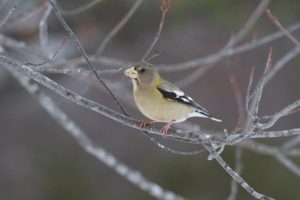
Box elder, sunflower seeds and spruce budworm outbreaks – tasty treats
As the Europeans settled and moved west from the east coast in the mid-to-late nineteenth century, they imported their box elder trees. Planted ornamentally in new cities as well as for windbreaks, box elder seeds were soon devoured by Evening Grosbeaks during the fall and winter. It is theorized that this could possibly have lured the Evening Grosbeaks eastward.
The increase of birdwatchers and ample supplies of sunflower seeds in their feeders also increased the menu options for Evening Grosbeaks along the way. Sunflower seeds are one of their favorites.
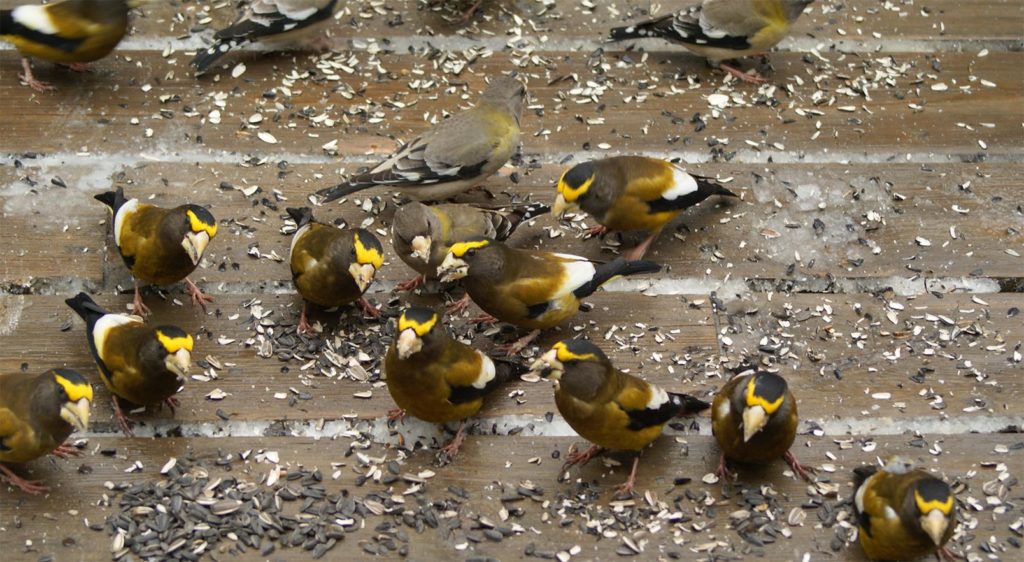
“In the 1970s and 80s, they were a very common feeder bird, so people wonder: where are they now?” explains Sparky Stensaas. A biologist, naturalist, and author of Winter Finches & Friends of North America: A Naturalist’s Handbook, Stensaas is the Executive Director of Friends of the Sax Zim Bog. He’s been watching the winter finches and boreal birds at the bog north of Floodwood, MN for 34 years. This 486-acre bog with coniferous and mixed forest, including tamaracks and black spruce, attracts many boreal birds. The presence of Evening Grosbeaks that show up here have not changed much, reports Stensaas, and is consistent at the feeders of a local resident, who reports 40 to 80 visiting per day.
Stensaas suggests today’s population of Evening Grosbeaks on the continent possibly reflects pre-boom numbers. The boom in population that expanded their range east was probably due to massive outbreaks of spruce budworm in Canadian boreal forests, he explains. “Their population was inordinately high back in the 70s and 80s because one of their main foods is the spruce budworm. There were Massive spruce budworm outbreaks across Canada at that time.” This included in New Brunswick, as well as the state of Maine. After Canada began forest management practices to control for spruce budworm, the count of Evening Grosbeaks in the northeastern part of the continent decreased, Stensaas points out.
How does it look for the Evening Grosbeak in Northern Minnesota? Health and management of forests matter
Climate adaptation, forest management and fire suppression can also impact the presence of the Evening Grosbeak in Minnesota, amongst many other variables, advises Lee Frelich, Director of The University of Minnesota Center for Forest Ecology. For now, it appears like the Evening Grosbeak will fare well enough in the coniferous forests of North and Northeast Minnesota for the next several decades. The northern Minnesota landscape is experiencing plenty of balsam firs right now, he reports. “In several decades all that fir is going to die from having the climate too warm, but right now fir is increasing,” said Frelich. This is related to fire suppression in the practice of forest management. “If you stop fires, you get more fir and less pine. This is true in the Boundary Waters,” said Frelich. “With the exclusion of fire in the last several decades there’s a lot more balsam fir on the landscape and a lot more budworm. Maybe the grosbeaks are taking advantage of that,” he suggests.
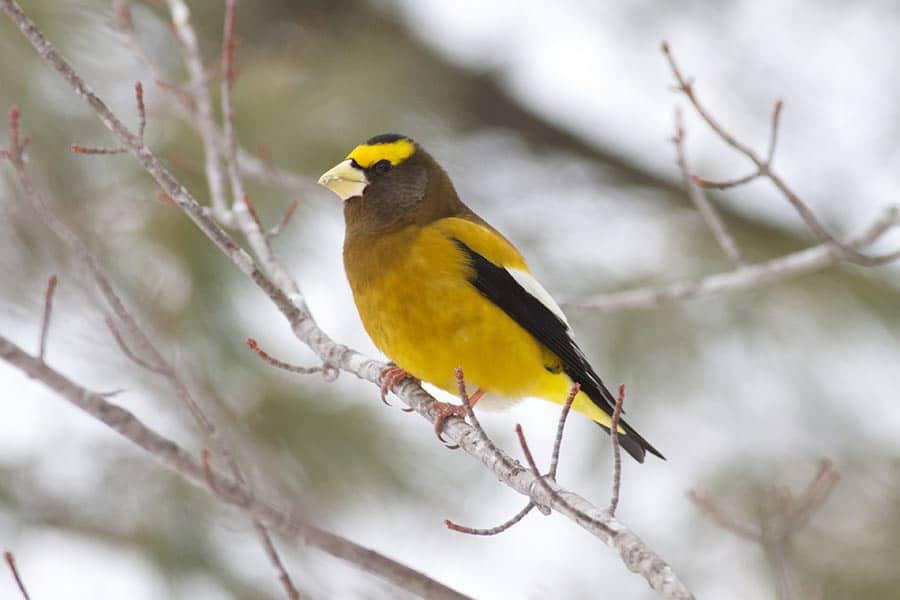
Climate Adaptation
We’re already seeing habitat impact in the boreal forests of Canada related to climate change and the increase in natural fires. “The warming we’ve experienced so far has been winter warming, which doesn’t affect things quite as much,” he explains. “Once the summers start to warm, certainly black spruce could disappear. That would change the habitat quite a bit for species that are pretty much dependent on coniferous trees.” Frelich expects this to start now and really kick in during the next few decades. “We think by 2050 we will certainly see a large magnitude of warming of the summers.”
Across the state, Evening Grosbeaks counts have decreased from 30% to less than 10% in the last fifteen years, according to data provided by the Audubon Christmas Bird Count. Few, if any, report seeing Evening Grosbeaks anywhere else in MN. Yet, in northern and northeast Minnesota sightings remain “frequently irregular”.

In the late fall of 2009, when Betty witnessed hundreds of grosbeaks in her own yard, Ely’s Christmas Bird Count for that winter reported 130 in a day, that same year — an irruption in one of those beautiful northern Minnesota winters, resplendent with one of our boreal treasures. Ultimately, Evening Grosbeaks bear watching as indicators of larger things happening in our region, and we will continue to enjoy these beautifully colored birds in our forests when we see them.
More Information:
Winter Finches & Friends Of North America: A Naturalist’s Handbook
Birds of North America: Evening Grosbeak
Minnesota Conservation Volunteer: Have You Seen A Grosbeak?
